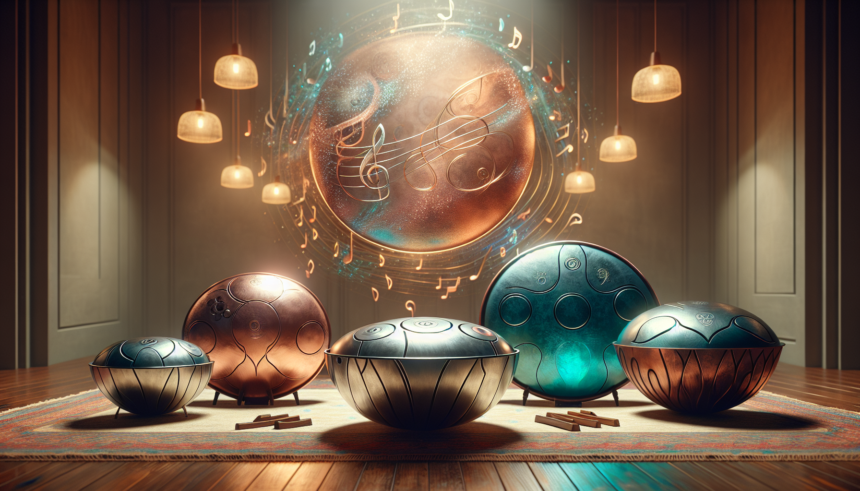<!DOCTYPE html>
<html lang="en">
<head>
<meta charset="UTF-8">
<meta name="viewport" content="width=device-width, initial-scale=1.0">
<title>Comparing Harmonics in Different Handpan Models</title>
<style>
body { font-family: Arial, sans-serif; line-height: 1.6; }
h1, h2, h3 { color: #333; }
ul { list-style-type: disc; padding-left: 20px; }
</style>
</head>
<body>
<article>
<h1>Exploring the Harmonics in Various Handpan Models</h1>
<p>
The handpan, an enchanting instrument that has captivated musicians and audiences worldwide, is renowned for its soothing soundscapes and harmonic richness. As more artisans enter the field, a variety of handpan models emerge, each offering a unique sonic architecture. This article dives deep into comparing the harmonics in different handpan models, offering insights into their construction, sound characteristics, and the auditory experience they present.
</p>
<h2>Understanding Harmonics in Handpans</h2>
<p>
Harmonics, in music theory, refer to the overtones that are produced alongside the fundamental tone when a note is played. They contribute significantly to the timbre, or quality, of the sound, giving each instrument its unique voice. In handpans, harmonics are crucial for their ethereal and resonant sound.
</p>
<h2>Comparative Analysis of Handpan Models</h2>
<p>
Various factors such as material, shape, scale, and tuning affect the harmonics of handpans. Below, we explore some prominent handpan models and their harmonic profiles:
</p>
<h3>Steel Handpans</h3>
<p>
Steel handpans, often the most recognized form due to their earlier introduction to the market, are known for their durability and bright sound. Made from nitrided steel, these models often feature a wide range of harmonics. The overtones produced are generally higher in frequency and more pronounced, offering a crisp and clear sound.
</p>
<p>
One of the noted comparisons is between the <em>original Hang</em> and modern steel handpans. The original Hang, developed by PANArt, had a unique identity due to its alloy and thermal treatment processes, producing harmonics that are mellower than the current stainless-steel versions. These modern versions, in contrast, tend to emphasize a broader spectrum of frequencies resulting in richer, more complex soundscapes.
</p>
<h3>Stainless Steel Handpans</h3>
<p>
Stainless steel handpans have become favored for their longevity and distinctive sound qualities. Their harmonics are often described as longer-sustaining and warmer compared to nitrided steel handpans. This extended sustain allows for a more immersive and dynamic play, especially suited for meditative environments.
</p>
<p>
The challenge with stainless steel models often lies in achieving a balance between the fundamental tone and the harmonics. Artisans investing significant skill into tuning these instruments can create handpans with harmonics that beautifully complement the fundamental, often yielding a more balanced and versatile sound.
</p>
<h3>Mixed Alloy Handpans</h3>
<p>
Mixed alloy handpans represent a fusion of materials, combining aspects of both traditional and stainless steel for a unique sound profile. The intention behind mixed alloys is to capture the best of both worlds: the durability and projection of steel with the warmth and sustain of stainless steel.
</p>
<p>
Harmonics in mixed alloy handpans can vary significantly depending on the specific blend and tuning techniques employed. These combinations often result in a diverse range of soundscapes, accommodating various playing styles and preferences.
</p>
<h2>Influences on Harmonic Production</h2>
<p>
The harmonic profile of a handpan is influenced not just by its material, but also by its design and craftsmanship. Here are some key factors that impact harmonic production:
</p>
<ul>
<li><strong>Shape and Size:</strong> The curvature and diameter of the handpan significantly affect sound resonance and harmonic distribution. A deeper dish may enhance lower harmonics, whereas a flatter design could emphasize higher frequencies.</li>
<li><strong>Tuning and Scale:</strong> Each handpan is tuned to a specific scale that dictates its harmonic range. Scales that include more notes often exhibit a richer harmonic interaction.</li>
<li><strong>Construction Techniques:</strong> Techniques such as hammering, rolling, and thermal treatment play a vital role in defining an instrument's harmonic signature.</li>
</ul>
<h2>The Auditory Experience</h2>
<p>
The ultimate test for any handpan's harmonics is the experience it provides to players and listeners. Each model delivers a distinct auditory journey:
</p>
<h3>Performance Context</h3>
<p>
In live performances, the harmonics of a handpan can significantly dictate the atmosphere. High-energy settings may benefit from bright, punchy overtones, while intimate, serene gatherings are better complemented by warm, lingering harmonics.
</p>
<h3>Recording and Production</h3>
<p>
In recording contexts, harmonics contribute to the depth and dimension of a track. The crispness and clarity of nitrided steel handpans might be favored in layered compositions, whereas the extended sustain of stainless-steel models could be ideal for ambient and solo tracks.
</p>
<h2>Conclusion</h2>
<p>
In comparing harmonics across different handpan models, it becomes clear that each offers a unique auditory palette. Steel, stainless steel, and mixed alloy handpans each have their strengths and best-use scenarios, dictated by their harmonic profiles. The choice between models ultimately hinges on individual preferences and intended uses, with the harmonic richness playing a central role in shaping their distinct identities. Whether you seek the bright overtone complexity of steel or the warm sustain of stainless steel, exploring these versatile instruments offers endless possibilities in musical expression.
</p>
<h2>Frequently Asked Questions</h2>
<ol>
<li>
<h3>What is the main difference between steel and stainless-steel handpans?</h3>
<p>Steel handpans generally offer brighter and more pronounced harmonics, whereas stainless-steel handpans are known for their warm, richer tones and extended sustain.</p>
</li>
<li>
<h3>How do harmonics affect the overall sound of a handpan?</h3>
<p>Harmonics contribute to the richness and complexity of a handpan's sound, influencing its timbre and the emotional impact of its music.</p>
</li>
<li>
<h3>Can the size of a handpan affect its harmonics?</h3>
<p>Yes, the size, particularly the diameter and shape, can affect resonance and harmonic distribution, impacting the tonal quality and harmonic richness.</p>
</li>
<li>
<h3>Are mixed alloy handpans a good choice for beginners?</h3>
<p>Mixed alloy handpans offer a versatile sound profile that can be appealing to beginners seeking a balance between warmth and projection. They're a great choice for those looking to explore varied tonal expressions.</p>
</li>
<li>
<h3>What types of handpan models are best for meditation music?</h3>
<p>Stainless steel handpans are often favored for meditation due to their longer sustain and warm harmonics, creating an immersive and calming atmosphere.</p>
</li>
</ol>
</article>
</body>
</html>Comparing Harmonics in Different Handpan Models

Leave a comment




